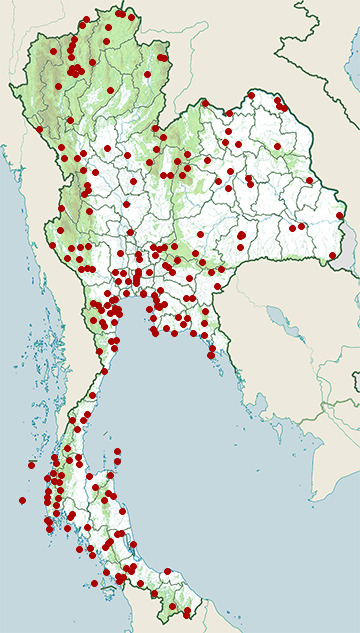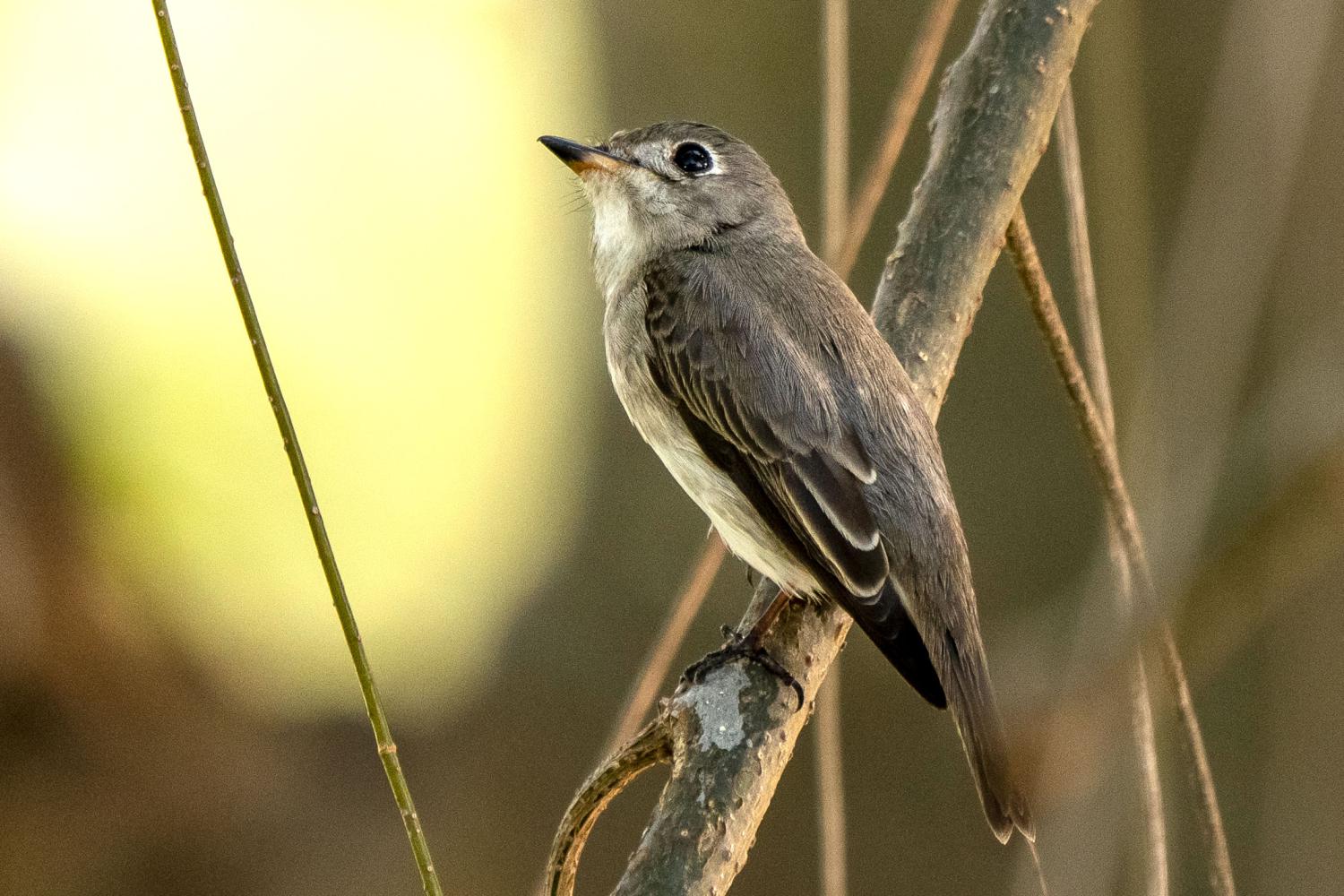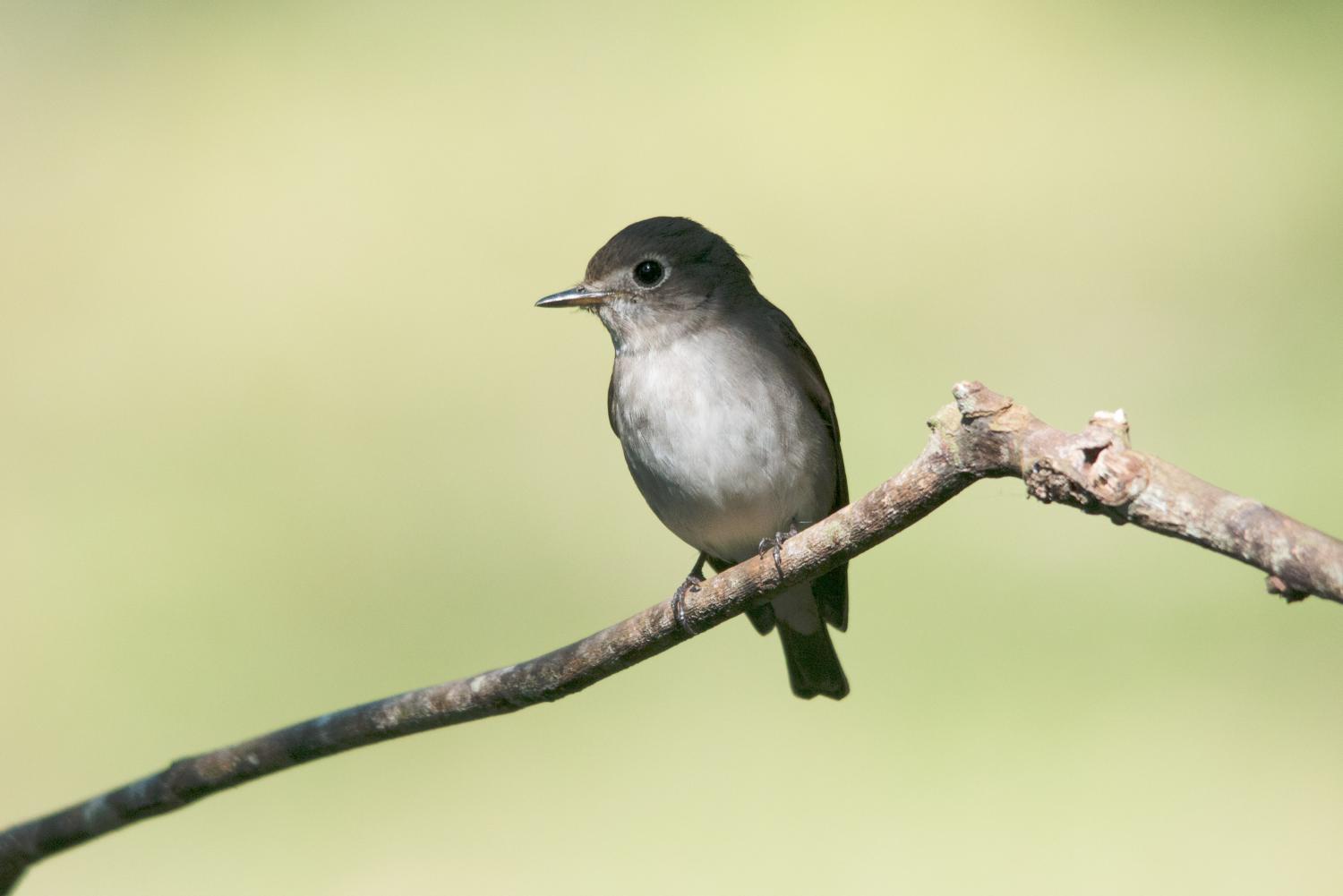Species of Thailand
Asian brown flycatcher
Muscicapa dauurica
Thomas Stamford Raffles, 1822
In Thai: นกจับแมลงสีน้ำตาล
The Asian brown flycatcher (Muscicapa dauurica) is a small passerine bird in the flycatcher family Muscicapidae. The word Muscicapa comes from the Latin musca, a fly and capere, to catch. The specific dauurica refers to Dauria, an area of south-eastern Siberia named after a local nomadic tribe.
This is an insectivorous species which breeds in Japan, eastern Siberia and the Himalayas. It is migratory and winters in tropical southern Asia from southern India and Sri Lanka east to Indonesia.
The correct specific epithet for this species is disputed.
Description
This species is 13 cm long, including the cocked tail. It is similar in shape to the larger spotted flycatcher, but is relatively longer-tailed. The dark bill is relatively large and broad-based.
The adult has grey-brown upperparts, which become greyer as the plumage ages, and whitish underparts with brown-tinged flanks. Young birds have scaly brown upperparts, head and breast.
Geographical variation
Although usually treated as monotypic if the brown-streaked flycatcher is not included, Rasmussen and Anderton, in Birds of South Asia. The Ripley Guide argue that populations in the Indian subcontinent and the Andaman Islands should be regarded as a separate subspecies, poonensis, from the nominate race which occupies most of the species' range. They describe poonensis as paler and browner above, with a deeper bill, and mostly pale lower mandible, a more mottled throat, breast and flanks (in fresh plumage), less contrastingly white "spectacles" and throat, and perhaps a more rounded wing.
Behaviour
Asian brown flycatcher is a common bird found in open woodland and cultivated areas. It nests in a hole in a tree, laying four eggs which are incubated by the female.
The male Asian brown flycatcher sings a simple melodic song during courtship.
This bird is parasitised by the chewing louse Philopterus davuricae.
Vagrancy
The Asian brown flycatcher is an extremely rare vagrant to Western Europe. Records have come from Britain, Denmark, and Sweden, and in addition, there are unproven claims from Ireland, Faeroe, and Norway.
Britain
On 3 October 2007 a first winter brown flycatcher was discovered at Flamborough Head, East Riding of Yorkshire which attracted hundreds of birdwatchers during its stay which lasted until dusk of the following day. This looks set to become the first accepted record. A previous record, on Fair Isle, on 1–2 July 1992 was regarded by the BOURC as not definitely of wild origin. A bird had also been claimed on Holy Island, Northumberland on 9 September 1956, but the identification was not accepted with beyond doubt.
This article uses material from Wikipedia released under the Creative Commons Attribution-Share-Alike Licence 3.0. Eventual photos shown in this page may or may not be from Wikipedia, please see the license details for photos in photo by-lines.
Category / Seasonal Status
Wiki listed status (concerning Thai population): Resident and winter visitor
BCST Category: Recorded in an apparently wild state within the last 50 years
BCST Seasonal statuses:
- Non-breeding visitor
- Resident or presumed resident
Scientific classification
- Kingdom
- Animalia
- Phylum
- Chordata
- Class
- Aves
- Order
- Passeriformes
- Family
- Muscicapidae
- Genus
- Muscicapa
- Species
- Muscicapa dauurica
Common names
- Thai: นกจับแมลงสีน้ำตาล
Subspecies
Muscicapa latirostris latirostris
Muscicapa latirostris poonensis
Muscicapa latirostris siamensis
Synonyms
- Muscicapa dauurica
Conservation status

Least Concern (IUCN3.1)
Photos
Please help us review the bird photos if wrong ones are used. We can be reached via our contact us page.
Range Map

- Amphawa District, Samut Songkhram
- Ao Phang-Nga National Park
- Aranyaprathet District, Sa Kaeo
- Ban Bueng District, Chonburi
- Ban Laem District, Phetchaburi
- Ban Lat District, Phetchaburi
- Ban Phai District, Khon Kaen
- Ban Pho District, Chachoengsao
- Bang Lamung District, Chonburi
- Bang Lang National Park
- Bang Len District, Nakhon Pathom
- Bang Pahan District, Phra Nakhon Si Ayutthaya
- Bang Pakong District, Chachoengsao
- Bang Phra Non-Hunting Area
- Bang Pu Recreation Centre
- Bang Saphan Noi District, Prachuap Khiri Khan
- Bangkok Province
- Bueng Boraped Non-Hunting Area
- Bueng Khong Long Non-Hunting Area
- Chaiya District, Surat Thani
- Chaloem Phra Kiat District, Saraburi
- Chaloem Phrakiat Thai Prachan National Park
- Chaloem Rattanakosin National Park
- Chiang Dao District, Chiang Mai
- Chiang Dao Wildlife Sanctuary
- Chiang Khong District, Chiang Rai
- Chiang Saen District, Chiang Rai
- Dan Sai District, Loei
- Doi Inthanon National Park
- Doi Lang
- Doi Pha Hom Pok National Park
- Doi Phu Kha National Park
- Doi Saket District, Chiang Mai
- Doi Suthep - Pui National Park
- Erawan National Park
- Hala-Bala Wildlife Sanctuary
- Hat Chao Mai National Park
- Hat Wanakon National Park
- Hat Yai District, Songkhla
- Huai Chorakhe Mak Reservoir Non-Hunting Area
- Huai Kha Khaeng Wildlife Sanctuary
- In Buri District, Sing Buri
- Kabin Buri District, Prachinburi
- Kaeng Khoi District, Saraburi
- Kaeng Krachan District, Phetchaburi
- Kaeng Krachan National Park
- Kaeng Krung National Park
- Kamphaeng Saen District, Nakhon Pathom
- Kanthararom District, Sisaket
- Kantharawichai District, Maha Sarakham
- Khanom District, Nakhon Si Thammarat
- Khao Ang Rue Nai Wildlife Sanctuary
- Khao Banthat Wildlife Sanctuary
- Khao Chamao - Khao Wong National Park
- Khao Chong
- Khao Dinsor (Chumphon Raptor Center)
- Khao Khiao - Khao Chomphu Wildlife Sanctuary
- Khao Khitchakut National Park
- Khao Kradong Forest Park
- Khao Laem National Park
- Khao Laem Ya - Mu Ko Samet National Park
- Khao Lak - Lam Ru National Park
- Khao Luang National Park
- Khao Nam Khang National Park
- Khao Nan National Park
- Khao Nang Phanthurat Forest Park
- Khao Phanom Bencha National Park
- Khao Phra - Bang Khram Wildlife Sanctuary
- Khao Sam Roi Yot National Park
- Khao Soi Dao Wildlife Sanctuary
- Khao Sok National Park
- Khao Yai National Park
- Khao Yoi District, Phetchaburi
- Khlong Hoi Khong District, Songkhla
- Khlong Lan National Park
- Khlong Nakha Wildlife Sanctuary
- Khlong Phanom National Park
- Khlong Saeng Wildlife Sanctuary
- Khlong Wang Chao National Park
- Khon San District, Chaiyaphum
- Khuan Khanun District, Phatthalung
- Khun Chae National Park
- Khun Nan National Park
- Khun Phawo National Park
- Khung Kraben Non-Hunting Area
- Khura Buri District, Phang Nga
- Klaeng District, Rayong
- Ko Chang District, Trat
- Ko Chang National Park
- Ko Lanta National Park
- Ko Libong
- Ko Phra Thong
- Ko Samui District, Surat Thani
- Ko Sichang District, Chonburi
- Kui Buri National Park
- Kumphawapi District, Udon Thani
- Laem Ngop District, Trat
- Laem Pak Bia
- Laem Son National Park
- Lan Sang National Park
- Mae Mo District, Lampang
- Mae Moei National Park
- Mae Ping National Park
- Mae Rim District, Chiang Mai
- Mae Sot District, Tak
- Mae Taeng District, Chiang Mai
- Mae Wong National Park
- Mancha Khiri District, Khon Kaen
- Mu Ko Phetra National Park
- Muak Lek District, Saraburi
- Mueang Buriram District, Buriram
- Mueang Chiang Mai District, Chiang Mai
- Mueang Chiang Rai District, Chiang Rai
- Mueang Chonburi District, Chonburi
- Mueang Chumphon District, Chumphon
- Mueang Kamphaeng Phet District, Kamphaeng Phet
- Mueang Kanchanaburi District, Kanchanaburi
- Mueang Khon Kaen District, Khon Kaen
- Mueang Krabi District, Krabi
- Mueang Maha Sarakham District, Maha Sarakham
- Mueang Nakhon Nayok District, Nakhon Nayok
- Mueang Nakhon Pathom District, Nakhon Pathom
- Mueang Nakhon Ratchasima District, Nakhon Ratchasima
- Mueang Nan District, Nan
- Mueang Nong Khai District, Nong Khai
- Mueang Nonthaburi District, Nonthaburi
- Mueang Pathum Thani District, Pathum Thani
- Mueang Pattani District, Pattani
- Mueang Phang Nga District, Phang Nga
- Mueang Phetchabun District, Phetchabun
- Mueang Phetchaburi District, Phetchaburi
- Mueang Phitsanulok District, Phitsanulok
- Mueang Phuket District, Phuket
- Mueang Prachinburi District, Prachinburi
- Mueang Ratchaburi District, Ratchaburi
- Mueang Rayong District, Rayong
- Mueang Samut Sakhon District, Samut Sakhon
- Mueang Samut Songkhram District, Samut Songkhram
- Mueang Satun District, Satun
- Mueang Sisaket District, Sisaket
- Mueang Sukhothai District, Sukhothai
- Mueang Suphanburi District, Suphan Buri
- Mueang Surat Thani District, Surat Thani
- Mueang Tak District, Tak
- Mueang Udon Thani District, Udon Thani
- Nam Nao National Park
- Namtok Phlio National Park
- Namtok Sam Lan National Park
- Nong Bong Khai Non-Hunting Area
- Nong Plak Phra Ya – Khao Raya Bangsa Non-Hunting
- Nong Ya Plong District, Phetchaburi
- Pachee River Wildlife Sanctuary
- Pai District, Mae Hong Son
- Pak Chong District, Nakhon Ratchasima
- Pak Khat District, Bueng Kan
- Pak Kret District, Nonthaburi
- Pak Phanang District, Nakhon Si Thammarat
- Pak Phli District, Nakhon Nayok
- Pak Thale
- Pang Sida National Park
- Pang Sila Thong District, Kamphaeng Phet
- Pha Daeng National Park
- Pha Taem National Park
- Phan District, Chiang Rai
- Phato District, Chumphon
- Phi Phi Islands
- Phra Nakhon Si Ayutthaya District, Phra Nakhon Si Ayutthaya
- Phu Chong Na Yoi National Park
- Phu Foi Lom National Park
- Phu Hin Rong Kla National Park
- Phu Khiao Wildlife Sanctuary
- Phu Kradueng National Park
- Phu Langka National Park
- Phu Phan National Park
- Phu Sa Dok Bua National Park
- Phu Suan Sai National Park
- Phu Wiang National Park
- Phu Wua Wildlife Sanctuary
- Phutthamonthon District, Nakhon Pathom
- Pran Buri District, Prachuap Khiri Khan
- Pran Buri Forest Park
- Sai Yok District, Kanchanaburi
- Sai Yok National Park
- Sakaerat Environmental Research Station
- Salak Pra Wildlife Sanctuary
- Samae San Island
- Samut Prakan Province
- San Kala Khiri National Park
- San Sai District, Chiang Mai
- Sanam Bin Reservoir Non-Hunting Area
- Sangkhom District, Nong Khai
- Sathing Phra District, Songkhla
- Sattahip District, Chonburi
- Sawi District, Chumphon
- Si Racha District, Chonburi
- Si Sawat District, Kanchanaburi
- Similan Islands
- Sirinat National Park
- Sri Nakarin Dam National Park
- Sri Phang-nga National Park
- Sukhirin District, Narathiwat
- Surin Islands
- Ta Phraya National Park
- Tai Rom Yen National Park
- Takua Pa District, Phang Nga
- Taphan Hin District, Phichit
- Tarutao National Marine Park
- Tat Mok National Park
- Tha Chana District, Surat Thani
- Tha Sala District, Nakhon Si Thammarat
- Tha Takiap District, Chachoengsao
- Tha Yang District, Phetchaburi
- Thai Mueang District, Phang Nga
- Thalang District, Phuket
- Thale Ban National Park
- Thale Noi Non-Hunting Area
- Than Sadet - Koh Pha-Ngan National Park
- Thanyaburi District, Pathum Thani
- Thap Lan National Park
- Thong Pha Phum National Park
- Thung Salaeng Luang National Park
- Thung Yai Naresuan Wildlife Sanctuary
- Ton Nga-Chang Wildlife Sanctuary
- Ton Pariwat Wildlife Sanctuary
- Wang Chan District, Rayong
- Wang Mai Forest Restoration Project
- Wat Phai Lom & Wat Ampu Wararam Non-Hunting Area
- Yan Ta Khao District, Trang




